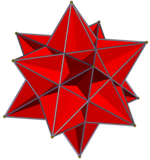Uniform star polyhedron
Appearance

In geometry, a nonconvex uniform polyhedron, or uniform star polyhedron, is a self-intersecting uniform polyhedron. It can contain either nonconvex polygon faces, nonconvex vertex figures or both.
Within the complete set of nonprismatic 53 uniform star polyhedra are 4 regular ones, called the Kepler-Poinsot solids.
There are also two infinite sets of uniform star prisms and uniform star antiprisms.
Here are two example star polyhedra, the first with five pentagram faces per vertex in a pentagonal vertex figure, and second with five triangles per vertex in a pentagrammic vertex figure:
 small stellated dodecahedron  Nonconvex faces: 5/2.5/2.5/2.5/2.5/2 vertex figure |
 Great icosahedron  Nonconvex vertex figure: (3.3.3.3.3)/2 |
See also
Reference
- Coxeter, H. S. M. (May 13, 1954). "Uniform Polyhedra". Philosophical Transactions of the Royal Society of London. Series A, Mathematical and Physical Sciences. 246, (916): 401–450.
{{cite journal}}: CS1 maint: extra punctuation (link) - Wenninger, Magnus (1974). Polyhedron Models. Cambridge University Press. ISBN 0-521-09859-9.
